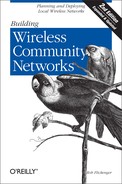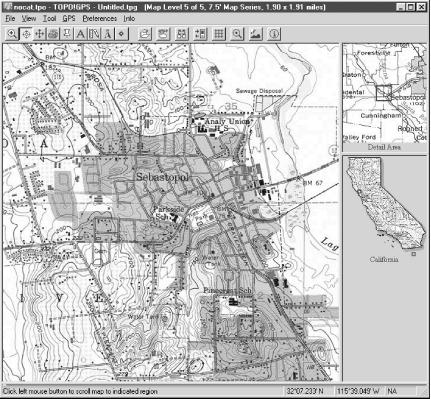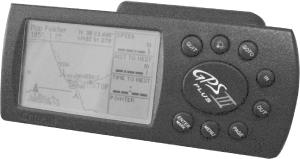You have an access point. Your laptop is humming merrily along. While working at home or the office is more flexible than ever, you find yourself wondering what it would take to get a signal across the street, at your favorite coffee shop.
Or maybe you live in an area where you’re on the perpetual “we’ll get back to you” list for broadband services such as DSL and cable modems and you’re ready to make it happen now. With the right equipment, enough participants, and the cooperation of the lay of the land, you can make broadband Internet access a reality in your neck of the woods.
Whatever your motivations, you are looking for a way to extend 802.11b beyond the listed 300-meter limit. This is not only possible and completely legal, it’s also a lot of fun. You first need to figure out what your target coverage area is, and what resources you need to make it happen.
While extending your private network for an extra block or two (or even several miles, with the proper antennas) may be interesting for you, it does nothing for those around you except generate more noise in the band. Most people will find it prohibitively expensive to rent tower space and set up network access for themselves, for wherever they happen to be in town. This has led to the fascinating phenomenon of the cooperative wireless network.
The single best piece of advice I can give you on your journey to the ultimate network (whether public or private) is to fight the urge to blindly go it alone. Get people from your local neighborhood involved. Call a general meeting of interested parties. Find other people in your area who are interested in similar goals, and get your resources together. If there aren’t any, join the development lists of any of the major community network groups (see Chapter 8) and ask around. Chances are, others have done (or are contemplating doing) what you want to do, and they’ll probably be more than happy to share their experiences.
As the number of people interested in wireless network access increases, a public-access network stands to benefit by access to more vantage points, both figurative and physical. While you might not have direct line of sight to a place you want to talk to, your neighbor might. And for complementary network access, they might just be willing to let you install some equipment and use their house as a repeater. Wireless bandwidth costs only electricity and equipment, not telephone or cable company charges. This kind of massively parallel, cooperative arrangement is what makes a high-speed wireless wide area network possible. However, I can only give you the technical details: the social details are left as an exercise to the reader.
If you want to stretch your signal more than just across the street, you’re going to have to consider exactly what lies between each point of your network. In Chapter 2, we looked at using USGS topographic maps and DOQs to estimate how the land lies between two arbitrary points. In addition to paper and online topographic maps, CD-ROM versions have been around for a few years. While typically geared toward hikers and outdoors enthusiasts, they have a lot to offer the aspiring wide area network engineer.
I have evaluated two popular commercial topo packages, Topo! by National Geographic, and DeLorme’s TopoUSA 2.0. While they’re both packed with features, only a few are directly applicable to helping analyze land between two points. Figure 6-1 shows a Topo! rendering of Sebastopol, California.
Here are some points to keep in mind when evaluating topo software for link analysis:
The software should provide cross-section views of a route or drawn trail. This is probably the feature used most often in trying to figure out if the land will cooperate (see the next section for examples).
Almost any self-respecting topo software package includes the ability to mark up the maps with points and text. The ability to import latitudinal and longitudinal data and translate it into data points is handy if you know a site only by that information.
If you intend to use a GPS with your software (see the next section), make sure your topo software supports your GPS hardware. Both packages I evaluated support most popular GPS hardware and the NMEA data standard (which virtually all modern GPS receivers speak).
Both packages that I currently use are for Windows only. There are lots of Linux mapping packages floating about that render USGS DOQs and DEMs, but, like a lot of Linux software, it may take a bit of fiddling to get them going. Check out the mapping resource links at the major community wireless sites listed in Chapter 8, as this is an area of rapid development in the open source community.
Whatever software you choose, it should make it easy to weed out, at a glance, the obviously impossible direct links. If you get a “maybe” (which is frequently the case), you’ll just have to go out and try it. Of course, for most of us, that’s the fun part.
Whenever I visit a potential node site, I bring my GPS with me. It logs not only the (more or less) precise latitude and longitude, but also the altitude of the site. This is data you can estimate with a topo map, but it can be handy to have in a precise measurement (particularly if you have logged several points in your intended network path). Figure 6-2 shows the use of GPS to tag potential sites.
After collecting points, you can pull them into your topo software and plot them. Draw routes between them to figure out how the land lies between the two points. Figure 6-3 shows a Topo! rendering of a site. Based on this representation, the shot should be a piece of cake.
Figure 6-3. Good topo software should be able to give you a cross-section lay of the land between any two points
Keep in mind that, although the topo software has surveyed geological data, it won’t have tree or building information. You can get a general idea of how cluttered an area is, but you won’t really know until you try the shot. Using the overhead view in conjunction with the cross section, you can not only weed out the obvious negatives, but also find potential workarounds.Figure 6-4 shows a site that wouldn’t work. Maybe you can go around it? Who lives on that hill, anyway?
Using the overhead view to locate key repeater points can be fun. Find out where the good sites are, and try contacting the people at those points. More often than not, people are willing to work with local community groups to provide free access (particularly if they don’t have to do much besides provide electricity while getting free high-speed access).
DeLorme has the interesting ability to create 3-D renderings of a topo region, complete with data markers and labels (Figure 6-5). While it’s a really cool feature (and is very catchy in presentations), it has limited practical value beyond helping to visualize the surrounding terrain.
Figure 6-5. DeLorme’s TopoUSA gives you a 3-D rendering of any topo region, complete with data points
Generally speaking, the more data points you collect, the more impressive your visual presentation will be.
Once your points are plotted on a map, you can very quickly determine which sites are worth developing. If you can’t get direct line of sight to a place you’d like, take a look at the surrounding geography and see if you can find another way. If you can’t go through, you’ll have to go over or around. Software topo maps can make finding the “bank shots” much easier.





